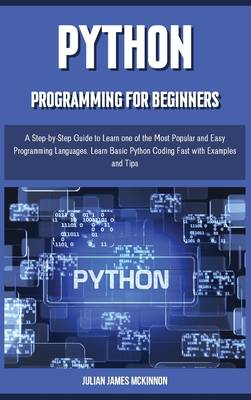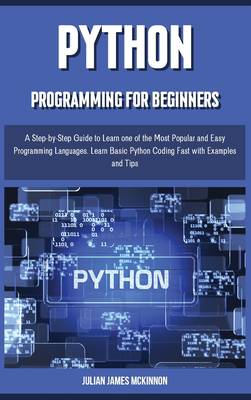
- Retrait gratuit dans votre magasin Club
- 7.000.000 titres dans notre catalogue
- Payer en toute sécurité
- Toujours un magasin près de chez vous
- Retrait gratuit dans votre magasin Club
- 7.000.0000 titres dans notre catalogue
- Payer en toute sécurité
- Toujours un magasin près de chez vous
PYTHON PROGRAMMING for beginners
A Step-by-Step Guide to Learn one of the Most Popular and Easy Programming Languages. Learn Basic Python Coding Fast with Examples and Tips
Julian James McKinnonDescription
Python was designed in the early 1980s. Initially, Python did not make its mark in the industry as intended due to the absence of adequate marketing. It also had some inbuilt problems relating to the key idea, which worked as an obstacle in its successful route.
With renovation by Google within the twentieth century, improvements were seen in Python, as some needed modifications were made in its set-up and settings.
As a consequence, it has acquired authority and efficiency within itself. Google altered the language's key logic and also removed all of the library's repeated modules and techniques to make it smoother and lighter.
Its efficiency has now improved more than three times than before. Therefore, it becomes one of the industry's most powerful languages, gaining tremendous popularity among developers and tech experts over the past decade, turning out to be a gem in the IT industry.
Today, many programming languages exist. Some are being used, and some are now deemed outdated. The programming situation has altered dramatically over the past few years as designers and programmers are looking for more universal and accessible languages, and this is why the language of Python has lately become so popular.
The Python community is increasing day by day, as many programmers find it one of the most user-friendly programming languages.
Python's development today involves different individuals with a broad spectrum of backgrounds, ages, and instructional levels. Whether you're a student, a computer designer, a housewife, or a retiree, you can be a part of the process.
There are always some thorough guidelines to make your introduction to the subject easier and more sustainable to ensure your success. Much guidance can be found on the Internet.
If you are starting with programming and have no knowledge about computers and programming, this book is written for you.
You will find initial chapters easier to understand, and as you progress to later chapters, you will have better skills, and we will cover more advanced topics.
This book is written in one flow, and it's better not to skip any topic, let alone an entire chapter.
This book gives a comprehensive guide on the following:
- The basic background of Python
- Data types in Python
- Operators - the types and their uses
- Loops and functions
- Exception handling
- Variable scope and lifetime in python functions
- Modules
- Working with files
- Object-oriented programming
- Real-world examples of Python
- Getting started; python tips and tricks
- Common programming challenges
- ...AND MORE!!!
What are you waiting for?
Spécifications
Parties prenantes
- Auteur(s) :
- Editeur:
Contenu
- Nombre de pages :
- 266
- Langue:
- Anglais
Caractéristiques
- EAN:
- 9781801875578
- Date de parution :
- 25-03-21
- Format:
- Livre relié
- Format numérique:
- Genaaid
- Dimensions :
- 152 mm x 229 mm
- Poids :
- 526 g

Les avis
Nous publions uniquement les avis qui respectent les conditions requises. Consultez nos conditions pour les avis.






